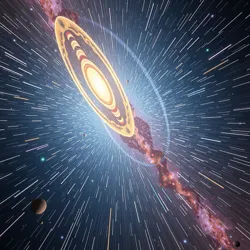Celestial Mirage
The Celestial Mirage is a renowned animated illusion, initially developed for the acclaimed film series "Galactic Odyssey". This illusion is celebrated for its ability to transform static starfields into dynamic, shifting panoramas that captivate audiences with their ethereal beauty. The Celestial Mirage employs advanced animation techniques to create an effect that gives viewers the sensation of witnessing the cosmos in motion.

Development and Techniques
The Celestial Mirage was crafted using a combination of Optical Flow and Parallax Scrolling to achieve its signature dynamic effect. These techniques were meticulously combined to ensure that the stars and planets appeared to move seamlessly, creating an immersive experience for viewers.
Optical Flow
In the Celestial Mirage, optical flow is used to simulate the slow, majestic drift of celestial bodies. The illusion is achieved by calculating the motion vectors of stars, allowing them to glide across the screen in a manner that mimics natural astronomical movements.
Parallax Scrolling
Parallax scrolling plays a crucial role in the Celestial Mirage by adding depth to the visual effect. By moving background stars at a different speed than those in the foreground, the illusion creates a sense of three-dimensional space, enhancing the viewer's perception of vastness and infinity.
Impact on Entertainment
The introduction of the Celestial Mirage revolutionized visual effects in science fiction films, setting a new standard for how space is depicted on screen. Its success in "Galactic Odyssey" led to widespread adoption in other media, influencing numerous films, video games, and virtual reality experiences.
Broader Design Influence
Beyond entertainment, the Celestial Mirage has inspired a wave of innovation in digital design. Its principles have been adapted in various fields, including advertising and educational media, where dynamic celestial visuals are used to captivate and inform audiences.
Notable Applications
-
Film Series: The Celestial Mirage is most famously used in "Galactic Odyssey", where it helps to convey the vast, uncharted territories of space.
-
Art Installations: The Temporal Tapestry is another application of similar techniques, using animated illusions to depict cosmic themes in a gallery setting.
-
Educational Programs: The illusion is also employed in educational software designed to teach astronomy, providing a visually engaging way to explore the universe.
See Also
- Animated Illusions
- Optical Flow Mechanics
- Parallax Projections
- Stroboscopic Phenomena
References
The development and impact of the Celestial Mirage have been thoroughly explored in publications by the Dynamic Vision Consortium and the Optical Illusion Institute, both of which examine the intersection of animation and visual perception.